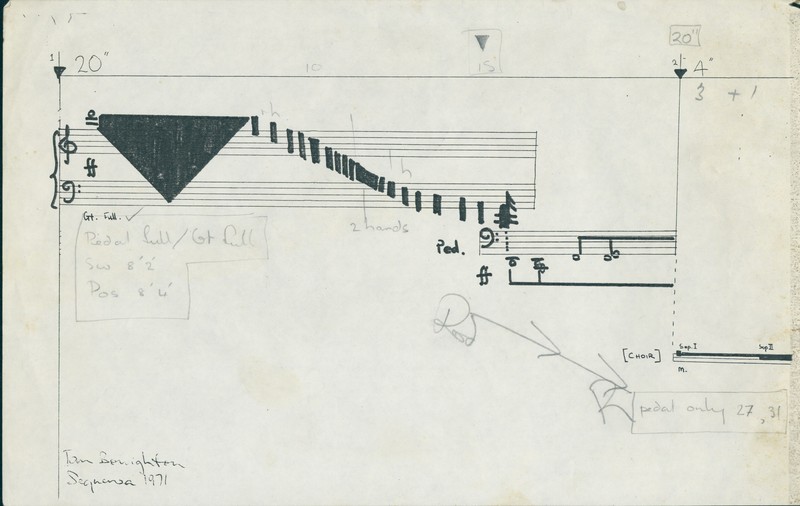Ian Bonighton, Sequenza, 1971
Dublin Core
Title
Ian Bonighton, Sequenza, 1971
Subject
Description
Ian Bonighton, Sequenza, 1971
Grainger Museum Archive, 2017/23-2/10
Ian Bonighton (1942-1975) graduated in Music from the University of Melbourne in 1968, studying composition with Keith Humble. He was appointed to the teaching staff of the Conservatorium of Music, and for the next six years he continued his study with Humble, taking Masters and Doctoral degrees in composition. He was part-time Curator of the Grainger Museum from 1970-73, taking every opportunity to study Percy Grainger’s scores and Free Music experiments in the Grainger Archive at first hand.
Bonighton’s Doctorate of Music, completed in 1972, focused on electronic music. Bonighton rarely composed purely electronic music, however, typically combining acoustic instruments such as organ or vocal ensembles, with prepared tape sounds. Bonighton’s instruction sheets for the realisation of In Nomine, utilising the EMS VCS3, show just how challenging working with these new instruments was, for both composers and performers.
To further his skills and experience in electronic music internationally, Bonighton left Australia in 1974 on a travel grant from the Music Board of the Australia Council. He inspected electronic music studios in Stockholm, Utrecht, York and Cardiff. In London he spent time at the EMS studios, working with Peter Zinovieff, David Cockerell, and Tristram Cary. He was already very familiar with the EMS instruments, from the Grainger Centre. Bonighton’s tragic death in 1975 robbed the Australian experimental music world of a great talent.
For the first composers of electronic music, there was a tension between the creation of new sounds never heard before in a musical context, and the necessity to represent these in a way that future musicians could interpret for performance or study. Graphic scores, such as Stockhausen’s Kontakte and Humble’s Music for Monuments and Statico I, are examples of the creative solutions that composers invented for this purpose.
Traditional notation systems were replaced by graphic elements, such as undulating lines or circling points, shapes such as squares and rectangles filled with tone, or even colour. Graphic scores were also useful for representing ‘chance’ music, overcoming of the concept of duration by leaving the ordering of different passages indeterminate. American composer Morton Feldman, who spent most of his career trying to erase any sense of metre from his music, used graphic scores in order to make time “less perceptible as movement, more conceivable as image”.
Grainger Museum Archive, 2017/23-2/10
Ian Bonighton (1942-1975) graduated in Music from the University of Melbourne in 1968, studying composition with Keith Humble. He was appointed to the teaching staff of the Conservatorium of Music, and for the next six years he continued his study with Humble, taking Masters and Doctoral degrees in composition. He was part-time Curator of the Grainger Museum from 1970-73, taking every opportunity to study Percy Grainger’s scores and Free Music experiments in the Grainger Archive at first hand.
Bonighton’s Doctorate of Music, completed in 1972, focused on electronic music. Bonighton rarely composed purely electronic music, however, typically combining acoustic instruments such as organ or vocal ensembles, with prepared tape sounds. Bonighton’s instruction sheets for the realisation of In Nomine, utilising the EMS VCS3, show just how challenging working with these new instruments was, for both composers and performers.
To further his skills and experience in electronic music internationally, Bonighton left Australia in 1974 on a travel grant from the Music Board of the Australia Council. He inspected electronic music studios in Stockholm, Utrecht, York and Cardiff. In London he spent time at the EMS studios, working with Peter Zinovieff, David Cockerell, and Tristram Cary. He was already very familiar with the EMS instruments, from the Grainger Centre. Bonighton’s tragic death in 1975 robbed the Australian experimental music world of a great talent.
For the first composers of electronic music, there was a tension between the creation of new sounds never heard before in a musical context, and the necessity to represent these in a way that future musicians could interpret for performance or study. Graphic scores, such as Stockhausen’s Kontakte and Humble’s Music for Monuments and Statico I, are examples of the creative solutions that composers invented for this purpose.
Traditional notation systems were replaced by graphic elements, such as undulating lines or circling points, shapes such as squares and rectangles filled with tone, or even colour. Graphic scores were also useful for representing ‘chance’ music, overcoming of the concept of duration by leaving the ordering of different passages indeterminate. American composer Morton Feldman, who spent most of his career trying to erase any sense of metre from his music, used graphic scores in order to make time “less perceptible as movement, more conceivable as image”.
Creator
Date
1971
Format
Instrument


